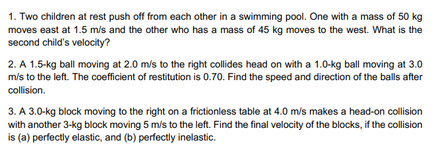1. Two children at rest push off from each other in a swimming pool. One with a mass of 50 kg moves east at 1.5 m/s and the other who has a mass of 45 kg moves to the west. What is the second child's velocity? 2. A 1.5-kg ball moving at 2.0 m/s to the right collides head on with a 1.0-kg ball moving at 3.0 mis to the left. The coefficient of restitution is 0.70. Find the speed and direction of the balls after collision. 3. A 3.0-kg block moving to the right on a frictionless table at 4.0 m/s makes a head-on collision with another 3-kg block moving 5 m/s to the left. Find the final velocity of the blocks, if the collision is (a) perfectly elastic, and (b) perfectly inelastic.
1. Two children at rest push off from each other in a swimming pool. One with a mass of 50 kg moves east at 1.5 m/s and the other who has a mass of 45 kg moves to the west. What is the second child's velocity? 2. A 1.5-kg ball moving at 2.0 m/s to the right collides head on with a 1.0-kg ball moving at 3.0 mis to the left. The coefficient of restitution is 0.70. Find the speed and direction of the balls after collision. 3. A 3.0-kg block moving to the right on a frictionless table at 4.0 m/s makes a head-on collision with another 3-kg block moving 5 m/s to the left. Find the final velocity of the blocks, if the collision is (a) perfectly elastic, and (b) perfectly inelastic.
Related questions
Question
answer 3

Transcribed Image Text:1. Two children at rest push off from each other in a swimming pool. One with a mass of 50 kg
moves east at 1.5 m/s and the other who has a mass of 45 kg moves to the west. What is the
second child's velocity?
2. A 1.5-kg ball moving at 2.0 m/s to the right collides head on with a 1.0-kg ball moving at 3.0
m/s to the left. The coefficient of restitution is 0.70. Find the speed and direction of the balls after
collision.
3. A 3.0-kg block moving to the right on a frictionless table at 4.0 m/s makes a head-on collision
with another 3-kg block moving 5 m/s to the left. Find the final velocity of the blocks, if the collision
is (a) perfectly elastic, and (b) perfectly inelastic.
Expert Solution
This question has been solved!
Explore an expertly crafted, step-by-step solution for a thorough understanding of key concepts.
This is a popular solution!
Trending now
This is a popular solution!
Step by step
Solved in 3 steps
